How to Fix the 0x800703EE Error with External Storages
A lot of Windows users are reporting a problem when copying files from or to an external storage device. The error code that comes up is 0x800703EE. The error message associated with this error code is ‘The volume for a file has been externally altered so that the opened file is no longer valid’.The issue is not specific to a certain Windows version since it’s confirmed to occur on Windows 7, Windows 8.1 and Windows 10.
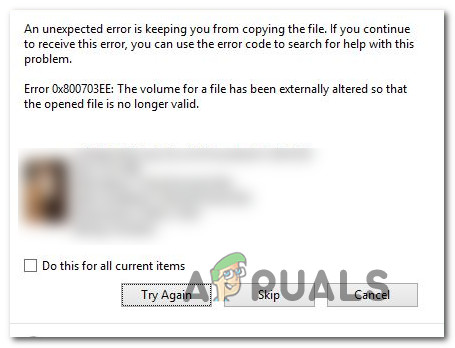
What is causing the 0x800703EE Error with external storages?
We analyzed this problem by looking at various user reports and the most common repair strategies that are typically deployed to fix this issue. As it turns out, there are several different potential culprits that might cause this problem on Windows PCs:
- 3rd party antivirus conflict – As it turns out, this issue can very well be caused by an overprotective 3rd party suite that is locking the file while Windows is attempting to move or copy it. If this scenario is applicable, you should be able to resolve the issue either by disabling the real-time protection or by uninstalling the security solution altogether.
- Back program is locking the file – If you’re using a backup program like Ease US, FBackup, Acronis True Image or a similar solution, chances are a service belonging to it might be causing the error. Windows is notoriously known to behave erratically when having to perform an operation while a different 3rd party application is also using the file.
- Different 3rd party conflict – It’s also possible that you have a different 3rd party program or that’s causing the program which hasn’t been reported by other users in a similar scenario. In this case, the best course of action would be to use the System Restore wizard to restore your machine to a state in which the error didn’t occur.
- Corrupted or glitched USB controllers – Improperly installed USB Serial controllers or glitched USB controllers can also be responsible for this problem. In this case, the only way to resolve this issue is to uninstall all USB controllers and rely on Windows to reinstall them or install them manually using your motherboard drivers.
- Windows Backup and Volume Shadow Copy are disabled – These two services will undoubtedly trigger the 0x800703EE in situations where one or both these services are Disabled. Windows relies on those services to complete file copying and moving operations, so make sure to have them enabled in the event that they are not.
- Burner / iTunes Filter drivers conflict – If you’re encountering the issue when copying from pen drives, SD cards or the likes, it’s very likely that you’re dealing with some kind of conflict caused by a burner software or by iTunes. If this scenario is applicable, you should be able to resolve the issue by deleting the Filter Drivers using Registry Editor.
- Underlying system file corruption – It’s also possible that the error code is the result of an underlying system file corruption that is preventing Windows from performing basic chores like copying and moving files. In this case, you should be able to resolve the issue by repairing corrupted system files with built-in utilities like SFC and DISM.
In the event that you’re struggling to resolve the very same error message, this article will provide you with several different troubleshooting guides that will help you pinpoint & fix the problem that’s triggering the 0x800703EE Error. Down below, you’ll find a collection of methods that have been confirmed to work by at least one affected user.
If you want to be as efficient as possible, we advise you to follow the methods below in the order that they are presented. Eventually, you should stumble upon a fix that resolves the issue regardless of the culprit that’s causing it.
Let’s begin!
Method 1: Disabling 3rd party antivirus
As it turns out, an overprotective Antivirus suite can also be responsible for the apparition of the 0x800703EE Error when copying files to or from external storage. In most cases. this will occur because the security suite is effectively locking the file while the security check is performed. If the procedure takes longer than expected, Windows might throw this error message as a result.
Several affected users have reported that they managed to circumvent the issue by disabling the real-time protection of the AV suite while the operation is running. If the procedure completes without issues, you can then safely re-enable the real-time protection once again.
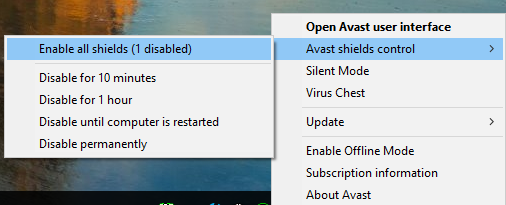
If you’re overly annoyed by this error as you frequently perform operations that end up triggering this issue, the only way to get rid of them for good is to let go of your AV suite and migrate to a different 3rd party solution or to the built-in solution (Windows Defender).
In the event that you decide to let go of your security suite, follow this article (here) to uninstall your security program without leaving behind any remnant files.
If this method is not applicable to your particular scenario or this method didn’t fix the issue for you, move down to the next potential fix below.
Method 2: Uninstalling EaseUS (or a different backup program)
As several different users have reported, this particular issue can also occur if you have a backup program currently installed that is preventing the copying to or from the external storage. Ease Us, FBackup and Acronis True Image are top of the list of culprits in this case, but they can be others.
Windows is not particularly fond of letting a 3rd party utility to use the same file while a copying operation is performing, so it throws the 0x800703EE Error instead.
Several affected users have reported that they managed to resolve the issue in this case by uninstalling the backup program and restarting their computer. At the next startup sequence, most affected users have reported that the issue stopped occurring for them.
Here’s a quick guide on uninstalling EaseUs or a different backup program that might be causing the 0x800703EE error indirectly:
- Press Windows key + R to open up a Run dialog box. Next, type “appwiz.cpl” inside the text box and hit Enter to open up the Programs and Features utility.

Type appwiz.cpl and Press Enter to Open Installed Programs List - Once you’re inside the Programs and Features window, scroll down through the list of applications and locate the backup software that you suspect might be triggering the issue.
- Right-click on it and click on Uninstall from the context menu to begin the uninstallation. At the uninstallation window, follow the on-screen prompts to complete the process.
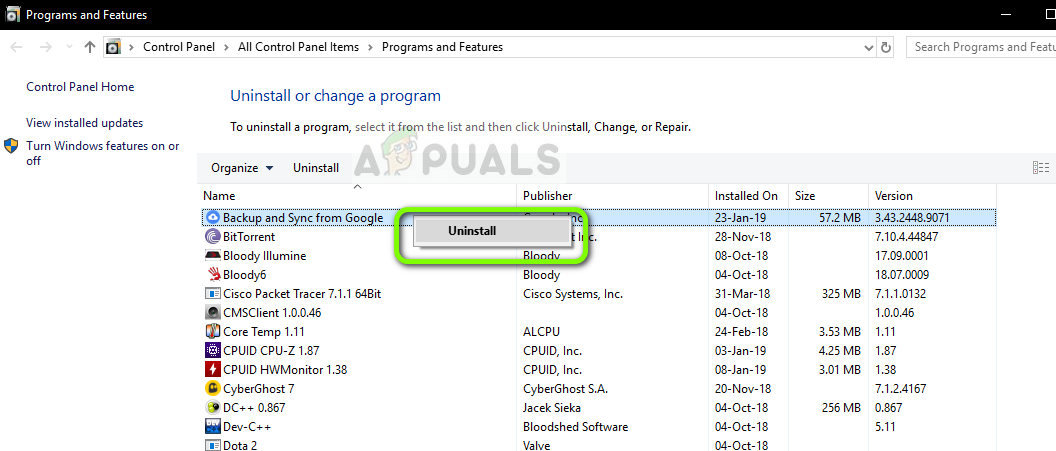
Uninstalling the backup software - When the backup software is uninstalled, restart your computer.
- Once the next startup sequence is complete, repeat the action that was previously triggering the 0x800703EE error and see if the issue has been resolved.
If the same error is still occurring, move down to the next method below.
Method 3: Reinstalling USB Controllers
Based on various user reports, it turns out that the 0x800703EE error might also occur if the USB Serial Bus controller used by the external device is not installed correctly or has became tainted by file corruption.
If this scenario is applicable, you should be able to resolve the issue by using Device Manager to remove and reinstall all USB controller that might contribute to the apparition of this problem. By doing this and restarting your computer, you’ll force your Windows to automatically reinstall the USB controller drivers, which should end up resolving the issue.
Here’s a quick guide on uninstalling & reinstalling the USB controllers using Device Manager:
- Press Windows key+ R to open up a Run dialog box. Then, type ‘devmgmt.msc’ and press Enter to open up Device Manager. If you’re prompted by the UAC (User Account Control), click Yes to grant admin privileges.

Typing “devmgmt.msc” in the run prompt. - Once you’re inside Device Manager, scroll down through the list of available device and expand the drop-down menu associated with Universal Serial Bus controllers. When you get there, right-click every Host controller under Universal Serial Bus controller and choose Uninstall device from the context menu. Then click Yes at the confirmation prompt to uninstall the device.
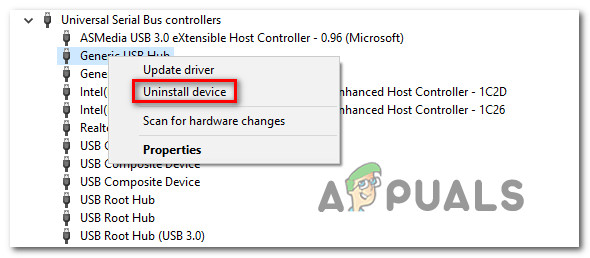
Uninstalling very USB controller - Do this consistently until every USB host controller is uninstalled, then close Device Manager and restart your computer.
- At the next startup sequence Windows should automatically recognize that you’re missing some USB drivers and install the missing host controllers.
Note: If you have an older Windows version, WU might not be that efficient in installing the missing drivers. in this case, you need to install the missing USB controller drivers from your manufacturer’s website (preferable) or from the installation media that you received with your motherboard. - Once the USB host controller drivers are uninstalled, repeat the action that was previously triggering the error and see if it’s now resolved.
If you’re still encountering the 0x800703EE error, move down to the next method below.
Method 4: Enabling Windows Backup and Volume Shadow Copy
Another potential reason why you’d encounter the 0x800703EE error is the fact that one or both of these Windows services are disabled:
- Windows Backup
- Volume Shadow Copy
This is known to happen in instances where the services are both disabled – either by manual user intervention or by a different 3rd party software (most likely a RAM optimizer app). In this case, you will be able to resolve the issue by using the Services screen to change the status of the two services to Automatic.
Here’s a quick guide on enabling the two services (Windows Backup & Volume Shadow Copy) in order to resolve the 0x800703EE error:
- Press Windows key + R to open up a Run dialog box. Then, type “services.msc” inside the text box and press Enter to open up the Services screen.
Note: Depending on your security preferences, you might be prompted by the UAC (User Account Prompt). If that happens, click Yes to grant admin access. - Once you’re inside the Services screen, move over to the right-hand pane and scroll down through the list of services until you locate Volume Shadow Copy. Once you see it, right-click on it and choose Properties from the newly appeared context menu.
- Inside the Properties window, go to the General tab and change the Startup tab to Automatic. Then, click Apply to save the changes.
- When you’ve taken care of the first service, search for the Windows Backup service and repeat step 3 with it to ensure that it’s set to Automatic.
- Once both services are enabled, repeat the copying operation again and see if the issue is now resolved.
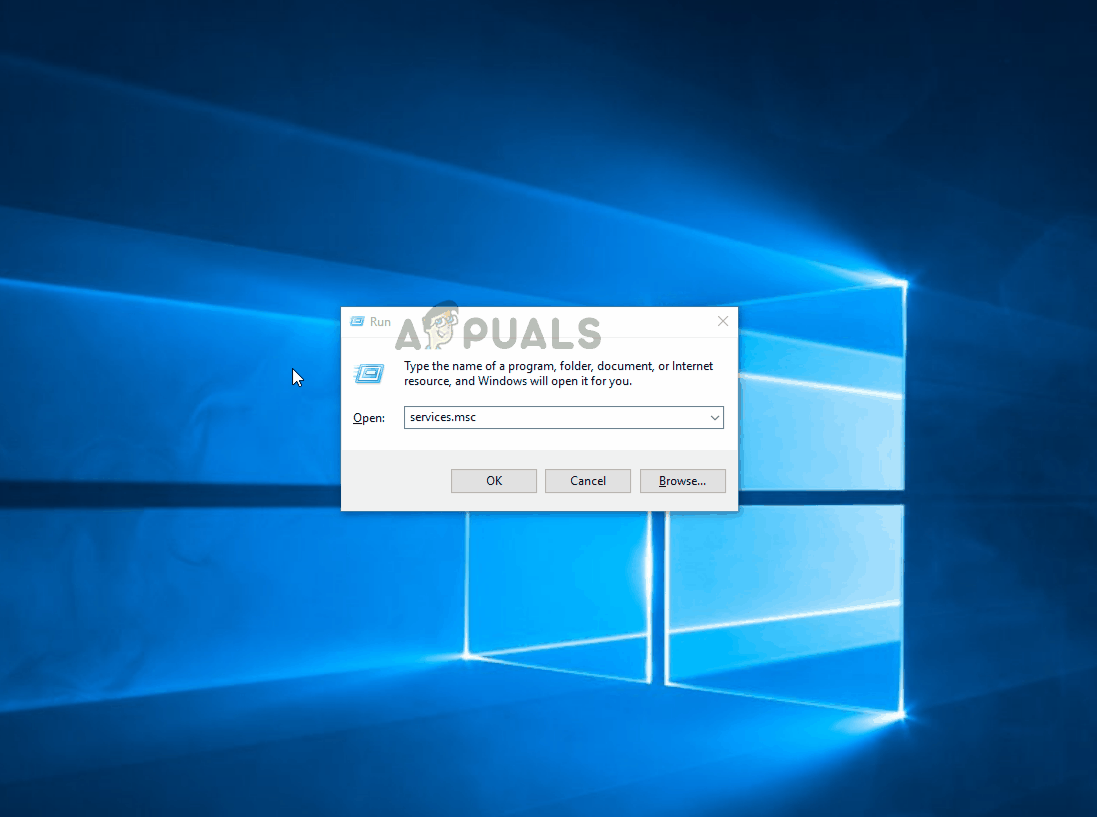
If you’re still encountering the same 0x800703EE error, move down to the next method below.
Method 5: Deleting the Filter Drivers
If you’re encountering this issue while you’re trying to transfer or copy files from pen drives, SDcards or other types of similar devices (including iPods or IPads), it’s very likely that you might be dealing with some type of conflict between the services used during this operation and your burner software.
If this scenario is applicable, you will be able to resolve the issue by deleting the Filter Drivers using the Registry Editor. But keep in mind that after you do this, you might see some ‘writing disk errors’ with your burning software or on Itunes until you reinstall them.
In the event that the description above is applicable to your current situation, here’s a quick guide on deleting the filter drivers using Registry Editor:
- Press Windows key + R to open up a Run dialog box. Then, type “regedit” inside the text box and press Enter to open up Registry Editor. When you’re prompted by the UAC (User Account Control), click Yes to grant administrative privileges.
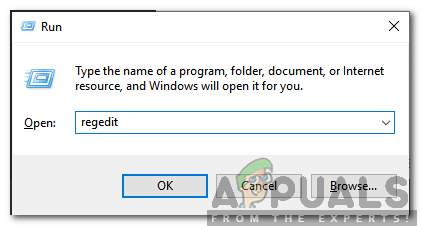
Typing in “Regedit” and pressing “Enter” - Once you’re inside Registry Editor, use the left-hand pane to navigate to the following location:
HKEY_LOCAL_MACHINE\SYSTEM\CurrentControlSet\Control\Class\{4D36E965-E325-11CE-BFC1-08002BE10318}Note: You can also get there instantly by pasting the location in the navigation bar at the top.
- Once you get to the correct location, let’s start things up by creating a backup, just in case you encounter any unexpected issues down the line. To do this, right click on the {4D36E965-E325-11CE-BFC1-08002BE10318} entry and choose Export. Then, select a convenable location to save the backup file and name it accordingly so you remember why you created it in the first place. Finally, hit Save to create the backup file.
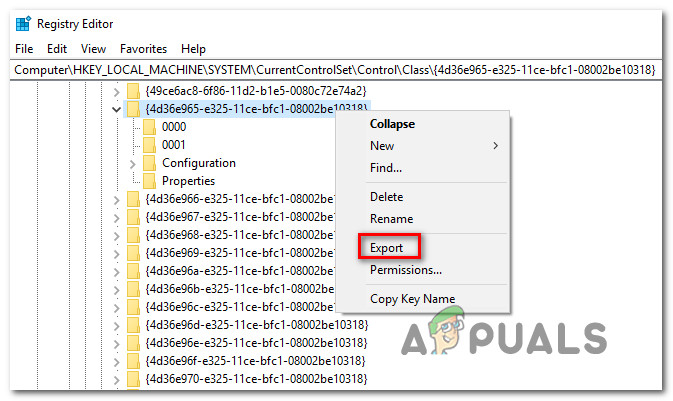
Exporting the key for backup purposes - Once the backup is in place, select the {4D36E965-E325-11CE-BFC1-08002BE10318} key, then move over to the right-hand pane. Once you get there, select both Upperfilters and Lowerfilters by holding the Ctrl key, then right-click on one of them and choose Delete from the context menu to get rid of them.
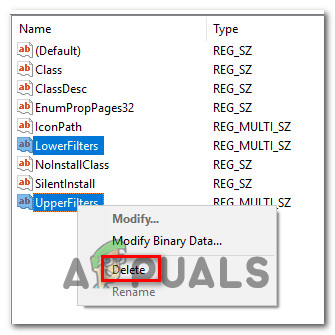
Deleting the filters responsible for the conflict - When both filters have been removed, restart your computer and repeat the action that was causing the error once the next startup sequence is complete to see if the issue is now resolved.
Note: In case you’re having other issues after performing the procedure above and you want to undo it, simply visit Computer\HKEY_LOCAL_MACHINE\SYSTEM\CurrentControlSet\Control\Class\ using Registry Editor and go to File > Import. Then, select the backup file that you previously created and you should be good to go.
If the same 0x800703EE error is still occurring, move down to the next method below.
Method 6: Performing SFC and DISM scans
The error code itself points toward a corruption issue. And although the issue is not actually caused by corrupted files, in some cases the 0x800703EE error occurs simply because Windows is dealing with a one or multiple system files that are corrupted and preventing the operation from completing.
Several affected users have reported that they were able to resolve the issue by repairing corrupted files with utilities like System File Checker (SFC) or Deployment Image Servicing Management (DISM).
Both utilities will ultimately repair system file corruption, but they do it differently. SFC uses a locally cached archive to replace corrupted system files with healthy copies while DISM relies on Windows Update to download the fresh copies needed to replace the bad ones.
But since the two utilities work best together, we highly encourage you to use both in order to ensure that you fix every possible corruption instance that might be causing this problem.
Here’s a quick guide on running SFC and DISM scans from an elevated Command Prompt:
- Press Windows key + R to open up a Run dialog box. Then, type ‘cmd’ inside the text box and press Ctrl + Shift + Enter to open up an elevated Command Prompt. When you’re prompted by the UAC (User Account Control), click Yes to grant administrative privileges.
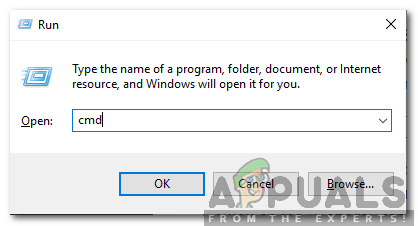
Typing cmd in the Run Prompt and pressing Shift + Alt + Enter to open an elevated Command Prompt - Once you’re inside the elevated Command Prompt, type the following command and press Enter to initiate the SFC scan:
sfc /scannow
Note: We don’t recommend that you stop the SFC scan at any point until the procedure is complete. Doing so will expose your system to even more system file corruption problems.
- When the scan is finished, restart your computer to finish the process. Once the next startup sequence is complete, follow step 1 again to open up another elevated CMD prompt and type the following command to initiate a DISM scan:
DISM /Online /Cleanup-Image /RestoreHealth
Note: Before you initiate this scan, make sure that you’re working with a stable internet connection. DISM needs internet access in order to download clean system files to use for replacement purposes.
- Once the DISM scan is finished, restart your computer again and test to see if the issue has been resolved once the next startup sequence is complete.
If you’re still encountering the 0x800703EE error when you try to copy to or from an external storage device, move down to the next method below.
Method 7: Doing a system restore
If you’ve come this far without a result, it’s clear that the issue is occurring for one of two reasons – it’s either a system file corruption issue that went undetected by the scans performed above or some kind of software conflict.
Fortunately, if the issue only started to occur recently, you should be able to resolve the issue easily just by using a system restore point to bring your computer back in time to a healthy state. If you’re lucky enough to have a system restore point dated just before the apparition of this issue, the procedure below should help you resolve the issue.
But keep in mind that this method will delete all changes that you made since the system restore point was created. All the apps you installed, the system preferences that you adjusted and everything else will be lost.
If you’ve decided to perform a system restore, here’s what you need to do:
- Press Windows key + R to open up a Run dialog box. Inside the text box of the run box, type ‘rstrui’ and press Enter to open up the System Restore wizard. If you’re prompted by the User Account Prompt, click Yes to grant admin access.

Opening the System Restore wizard via Run box - At the first screen of the System Restore wizard, click Next to advance to the next menu.
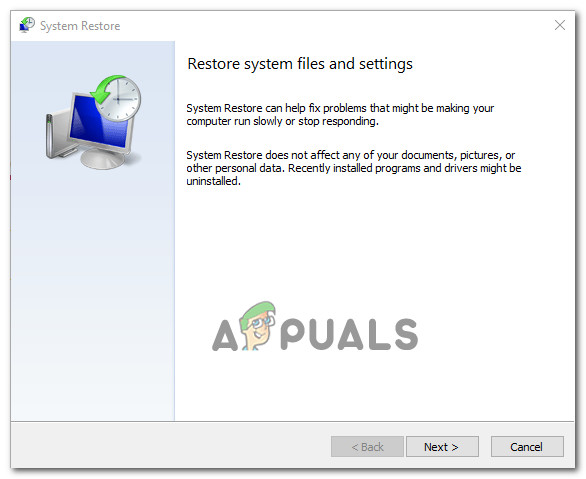
Getting past the initial screen of System Restore - At the next screen, click the box associated with Show more restore points first. Then, select the appropriate restore point (one that is dated before the apparition of the problem) and click on Next once again.
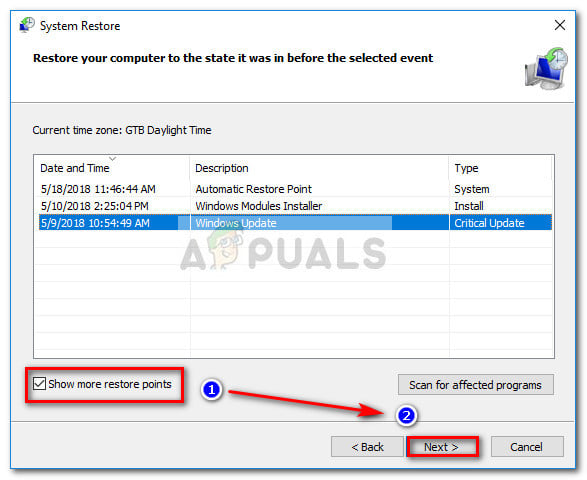
Enable Show more restore points box and click Next - Click Finish to start the recording process. Soon after you do this, your PC will restart and the old state will get enforced and your computer will revert to the state it was when the restore snapshot was created.
- Once the process is complete, see if the 0x800703EE error is still occurring by repeating the action that was previously causing it.




